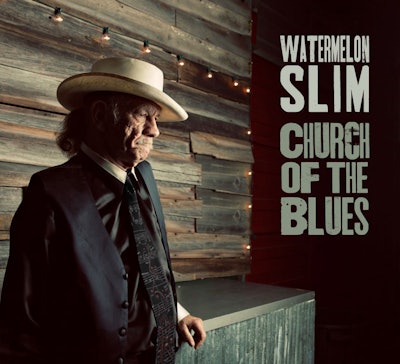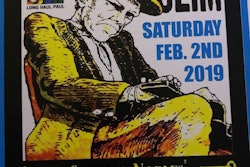The latest in “Long Haul Paul” Marhoefer’s Faces of the Road series:
 Preview former trucker Watermelon Slim’s new “Church of the Blues” record via this link.
Preview former trucker Watermelon Slim’s new “Church of the Blues” record via this link.Bluesman Watermelon Slim
Past jobs: Soldier, Household Mover, Hazmat Hauler, Log Trucker, Collections Agent, Petty Criminal, Dry Box Hauler, Funeral Officiator, Rolloff Operator, Sawmiller, Truck Patch Farmer, Lumper, Newspaper Reporter
Move over, bought and paid for beer-mongering pretty boys. We have found the actual Most Interesting Man in the World, and he is William P. (Bill) Homans III, also known as Watermelon Slim, a retired trucker (handle: “Watermelon”) turned international blues sensation.
“I’ve had a little success in a life marked mostly by failure.” –Watermelon Slim
It was more than eight years ago when Slim checked in with Overdrive‘s Todd Dills while touring. Retiring from trucking in 2004 to take one more shot at being a musician for his living, he had been discovered by the Canadian boutique label, Northern Blues, and had become the cause celebre of the blues community, garnering an unprecedented six Handy nominations in 2006.
Just weeks before said discovery, he was hauling industrial waste for HEW Recycling out of Stillwater, Okla., and occasionally singing on the CB. In fact, the former hauler’s life story includes details which depict a pattern of improbability so far-fetched it could only have happened to a gearjammer.

From petty criminal to multi-lingual member of MENSA, from honorably discharged Vietnam enlistee to psychedelic folk protest singer, from saw mill laborer to restaurateur with a master’s degree, the onetime trucker, who performs under the nom de plume Watermelon Slim, is poised to release his twelfth album, “Church of the Blues,” in a couple months.
A multi-instrumental virtuoso whose weapons include a lethal left-handed bottleneck slide guitar that he plays with a spark plug socket, as well as a formidable blues harp, Homans’ howling baritone beckons from the back of some boxcar, in a plaintive rasp and holler like something out of the Alan Lomax archives. His works have garnered praise from quarters ranging from blues aficionado Dan Aykroyd to multiple W.C. Handy awards and Hall of Fame memberships.
I caught up with Slim just days after his return to his adopted hometown of Clarksdale, Mississippi. Long considered ground zero for the blues, Clarksdale’s former residents include Muddy Waters, Howlin’ Wolf, John Lee Hooker, W.C. Handy, Bessie Smith, Willie Brown and even Tennessee Williams. Fresh from yet another successful European tour, he was at Shankerman’s Men’s Wear, just closing the deal on a couple of his trademark suits. An elegant dresser, the weathered bluesman cited the Muddy Waters dictum, “You’re cheating the customer if you don’t show up in your best clothes.”
As Floyd Shankerman, sole proprietor of the 100-year-old haberdashery on Yazoo Avenue, was cashing out his purchase of a red and white seersucker suit,Mr. Homans, the son of a Harvard attorney, began to tell me some stories from his life, which, despite a patrician Southern upbringing, would come to read more like the liner notes of “The Best of Little Walter,” circa 1958.
He first heard the blues in Asheville, N.C., in 1954 at the age of five, when Ms. Beulah Huggins, a domestic in his parents’ employ, would sing John Lee Hooker’s songs, including “One Bourbon, One Scotch, One Beer”, around the house. Homans was mesmerized by her constant improvisations, “Sometimes she’d sing, ‘one bourbon, one scotch, and one itty bitty beer’,” he said. This early introduction left an impression. Later, he would come to be raised by yet another employee of his parents, Mrs. Idell Gossett. Idell, twice a grandmother by age 34, “had my mother’s permission to rear and discipline me and my brother as her own,” he explained.
After hearing Slim sing for the first time, I frankly had to do a double-take on the album cover, as he sang with so much soul and pathos, I truly had no idea he was a white guy. While no one can measure the extent to which our earliest teachers influence us, it would seem that Ms. Huggins and Mrs. Gossett, African-Americans, had imparted a spiritual gift which transcended race to the youth who would later become Watermelon Slim. By the age of ten he was a serious student of the harmonica, which he would first come to master. His mother also permitted Homans a set of bongos.
“They weren’t real high quality, but they were not toys,” he said.
Then there was the matter of Vietnam. Slim, by his own account a “wannabe hippie,” not unfamiliar with LSD, shunned the college deferment route, which would become the well-worn path of many of his fellow students. Homans, who failed in his first try at college, volunteered instead for the United States Army. There was nothing unusual about this to the 19-year-old. His father had witnessed the horrors of Kristallnacht firsthand in 1938, as part of an American collegiate delegation in Germany, hosted by Hitler’s personal secretary and confidant, Ernst Hanfstaengl, himself a Harvard Man in the beginning of the 20th century. Mortified and enraged by what he saw, William Homans Jr. volunteered for the British Royal Navy, not wishing to wait around as America deliberated its options.
Both of Slim’s grandfathers had served in America’s wars, as well as two uncles, an aunt and a great aunt, who died in a French hospital days before the Armistice, and was posthumously awarded the French Croix de Guerre for her distinguished service as a front-line nurse in World War One. In fact, according to the old bluesman, dating back to the Revolutionary War, a Homans had always served in the military.
It was in Vietnam, while laid up by an extended illness at a Cam Ranh Bay hospital, that Slim negotiated in French the five dollar purchase of his first guitar from a “papasan” in a tiny commissary on the hospital grounds. “It was the nastiest old guitar you ever saw, but it did have all six strings on it,” he said. There, with a Zippo lighter and a broken shard of a coffee can top, he began to teach himself to play his unique, backwards style of bottleneck slide.
After returning stateside he would join the ranks of Vietnam Veterans Against the War (VVAW), and in 1973 released an LP titled “Merry Airbrakes,” a protest album he categorized as “psychedelic folk.” A cut from that record eventually appeared on a Country Joe McDonald compilation of music by Vietnam veterans. However, his music career would soon tank. A brief career in petty crime ensued, which he would forsake by 1978.
It appears what ultimately put Slim back on the straight and narrow was a love of grueling, repetitive manual labor. In his prime, he could fingerprint 90,000 pounds of boxcar freight in a ten-hour shift, as well as drive anything with wheels. (“No doubles, triples or tankers, thank you,” Slim laughs.) He eventually hired on as driver-packer with a small household moving van line along the Eastern seaboard, and settled into something like “the straight life.”What would follow would be nearly 30 years of hard labor and drifting, as well as a few more fits and starts at college that resulted in the acquisition of first a Bachelor’s degree (with honors) and, 14 years later, a Master of Arts degree.
Before that, during the 1970s, Homans even had a brief membership with MENSA, having a measured I.Q. of 142 on the Air Force Qualifying Test (AFQT); however, according to the former lumper, he had let his dues to the organization slide during a lean spell. He admits that at the time something as purely intellectual as MENSA bored him.
During the 1980s and 1990s, the man who had by then become Watermelon Slim did two long stays working at a back-country saw mill, which would claim part of a finger. “Death touched me and walked away,” he explained with a sense of awe. It was during those wilderness years he wrote some of his great blues “hollers” — a capella chants extemporaneously conceived and sung above the drone and grind of the machinery around him — as a means of bearing the drudgery of the task. One of these, “Sawmill Holler,” remains a favorite of this gearjammer. You can almost hear the howling 360 Detroit turning the 52-inch buzzsaw that had touched him.
On a 1999 trip to Clarksdale, Mississippi, in search of a position as assistant curator at the blues museum there, Slim wound up being robbed and beaten within inches of his life behind a juke joint, and left to die, with multiple compound fractures to his jaw and lacerations to his face. Upon determining he had no health insurance, the staff at the local hospital in Clarksdale, the Northwest Regional Medical Center, refused to treat him, and the Clarksdale Police sent him along his way.
Homans drove 555 miles back to his home in Oklahoma with a piece of jaw bone sticking through his tongue to receive treatment, for which he borrowed money from his aunt. The fractures had to be pieced back together with plates and pins. There was now barely a tooth left in his head. He added that the Stillwater dental surgeon did a great job putting him back together.
All this would be tragic for anyone else; Slim simply made it fodder for song after song. Left now with a grizzled, Charles Bukowski hard-luck face, one which a reviewer of one of his CDs described as resembling “a topographical map of west Texas,” he simply made it his trademark and calling card. Rest assured, good reader, there’s a story and a song for every line and scar on that mug. One writer would come to call his life “an ever-expanding portrait of ramshackle grandeur.”
“I’ve had a little success in a life marked mostly by failure,” he said. So he healed up and trucked on, picking up weekend gigs from time to time, while trying to hold his family together.
Eventually, that would turn around. One night in 2002 he met a man named Chris Hardwick of Norman, Oklahoma. A real estate appraiser by trade, and a music producer and promoter avocationally, Hardwick had been asked to record Slim’s weekend-warrior band at the time, “Fried Okra Jones,” for a local broadcast, “The Weekend Blues”, on KGOU-FM of Norman.
“They were setting up, and I noticed (Slim) was in the main room, doing push-ups,” Hardwick says. “I asked him what was going on and [he] said he was getting ready to perform. I was struck by how intense and sincere Bill played and performed. Plus, he penned all the songs and they were great songs.” He went on: “It was clear to me that Bill’s music must be heard and shared within the blues community.”
According to Slim, Hardwick “took thousands of dollars out of his own pocket to create a label (Southern Records) for me.” Hardwick, himself a musician, made it his mission to get Watermelon Slim to the venues that would take him seriously. Mr. Hardwick produced the truck-driving bluesman’s first national release, “Big Shoes to Fill,” and hired a publicist, as well, on his own dime.
The collaboration between Slim and Hardwick, which continues to this day, got him signed, under Hardwick’s masterful shepherding, to the Canadian label Northern Blues, whose president, former Intel executive Fred Litwin, heard him at a concert in Memphis and was blown away. The metamorphosis of Bill Homans, trucker and musical weekend warrior, to Watermelon Slim, internationally acclaimed blues virtuoso, had begun. Litwin assured Slim that he would no longer have to drive trucks or unload freight for a living.
“Blues is so raw and deceptively simple. There’s nowhere to hide, you’ve either ‘got it’ or you don’t,” says author, journalist, and music commentator Meredith Ochs. “Slim’s got it all. He burns on slide guitar and harp. He sings with that frayed, working man’s voice, but he also strikes just the right self-deprecating, comedic notes. He’s an eclectic dude, a true polymath, and apparently indestructible: trucking didn’t kill him, farming didn’t kill him, nor did Vietnam, academia, the music industry, nor a massive heart attack.”
In my Overdrive exclusive review of Watermelon Slim’s latest album, “Church of the Blues,” produced by Hardwick on the Northern Blues label, I could not help but notice the eerie prescience of a couple of Slim’s songs, such as “Charlottesville (Blues for My Nation),” where he decries the rise of “Nazis on our streets.” I received my digital copy just days before the most deadly attack on a Jewish community in this country’s 242-year history.
Then there is his treatment of the McKinley Morganfield classic “Gypsy Woman,” featuring a minute-and-a-half harp solo with his instrument never running out of things to say. My first instinct upon hearing this tour de force was to discard every harmonica in my possession and vow to The Almighty to never touch the instrument again.
Look, I’m just an English major who wound up driving a truck for 37 years, but I would honest to God place that break with Stevie Ray Vaughn’s solo on “Texas Flood.” It’s just that damn good. As I listened to the song over and over again during a rare three-day weekend, my wife Denise, accustomed to hearing my rudimentary harp solos while playing with the instrument in a rack to accompany myself on guitar, asked how he could ever be getting that many sounds out of an instrument.
So I asked Watermelon Slim himself, suspecting there were two harps in the solo, “what kind of gear did you use to get that tone?” The explanation I got was priceless. Here is the edited version:
“Equipment? Some kind of green bullet mike, an Alamo Jet amplifier (they’re from Texas, it’s the best harp amp I ever played on). Trent Bell, owner and engineer at Bell Labs, in Norman, refuses to sell the amp to me — must have cost less than $200 when new in the 1970s — for $2,000 or more. Harmonicas? Hohner Special 20s, stock out of the package. The song is in A, so I start with the D harp. Second position. The scale is A B C# D E F# G A. I switch in the solo to an A harp. Straight harp, or first position. Jimmy Reed’s usual position. The scale is A B C# D E F# Ab A. On the bottom, I bend the E (third hole drawn) to Eb, the blues note, a lot, and on the top I bend the top 3 notes blown, especially the top A down to G. Then after the ‘four,’ I hit the very highest notes in the solo by switching back to the D harp, and I finish the song with that harp. Thanks for asking. I never did explain anything like that before, nobody ever asked me.”
Turns out there were indeed two harps on the solo.
Rainer Maria Rilke once posited that art has a duty to surprise. There are hundreds, if not thousands, of little surprises in that solo, as scorching and as dangerous as the pivots between extremes that Watermelon Slim has negotiated throughout his eventful life. Still, the prescience of the lyrics would soon seep into the bluesman’s life, as it does with so much of Slim’s art. He just can’t shake it.
You’re living in the good times.
But there’ll be trouble after awhile.
Tragedy struck Watermelon Slim upon his return to Mississippi from his last tour in Europe. Slim was informed by a close friend that his faithful retriever, Pinot, had been murdered in a botched robbery attempt. The news had been concealed from him until he returned home. “They did right not to tell me because I would have blown off the rest of the tour,” Slim says, mournfully.
He had only been informed a day or so before our interview. Slim had just toured the most prestigious music circuits in Europe. You can watch fresh footage of him on Youtube as he regales his interviewers in Italian, his fans in Spanish. And now just months away from 70, the bluesman discovers the best dog he ever owned is gone. He has written a song about it, which I hope one day to hear.
But there was work to be done that day. Slim is part owner of The Bluesberry Cafe, in Clarksdale: “Down here on Yazoo, with Blues out the Wazoo.” When he’s off the road, he fills in as dishwasher, and cooks, I’m told, some mighty fine collard greens. Did someone say music pilgrimage?
Among the many songs Watermelon Slim has penned are some are the most cleverly composed trucking songs we here at Overdrive have ever heard. Though it has been eight years since Todd Dills has seen him perform, he still quotes Slim word for word like Dylan. Follow this link for a Spotify playlist of some of my favorite Watermelon Slim. He can also be found on Youtube, Soundcloud, and in most digital stores.
To see Slim’s touring schedule, or to purchase his albums, follow this link to his website. For my Indiana and Ohio readers, please note Watermelon Slim is coming to The Key Palace Theater in Redkey in February. He will be dressed to the nines, just like Muddy, John Lee, and B.B. were when they played at that iconic club. On some nights, when the crowd is just right, you can hear them all singing back to you, crying out through the mortar. I could hear them, last time I sang there. Hope to see you there.











